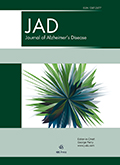Authors: Yoo, Han Soo | Kim, Han-Kyeol | Lee, Jae-Hoon | Chun, Joong-Hyun | Lee, Hye Sun | Grothe, Michel J. | Teipel, Stefan | Cavedo, Enrica | Vergallo, Andrea | Hampel, Harald | Ryu, Young Hoon | Cho, Hanna | Lyoo, Chul Hyoung
Article Type:
Research Article
Abstract:
Background: Degeneration of cholinergic basal forebrain (BF) neurons characterizes Alzheimer’s disease (AD). However, what role the BF plays in the dynamics of AD pathophysiology has not been investigated precisely. Objective: To investigate the baseline and longitudinal roles of BF along with core neuropathologies in AD. Methods: In this retrospective cohort study, we enrolled 113 subjects (38 amyloid [Aβ]-negative cognitively unimpaired, 6 Aβ-positive cognitively unimpaired, 39 with prodromal AD, and 30 with AD dementia) who performed brain MRI for BF volume and cortical thickness, 18 F-florbetaben PET for Aβ, 18 F-flortaucipir PET for tau, and detailed cognitive
…testing longitudinally. We investigated the baseline and longitudinal association of BF volume with Aβ and tau standardized uptake value ratio and cognition. Results: Cross-sectionally, lower BF volume was not independently associated with higher cortical Aβ, but it was associated with tau burden. Tau burden in the orbitofrontal, insular, lateral temporal, inferior temporo-occipital, and anterior cingulate cortices were associated with progressive BF atrophy. Lower BF volume was associated with faster Aβ accumulation, mainly in the prefrontal, anterior temporal, cingulate, and medial occipital cortices. BF volume was associated with progressive decline in language and memory functions regardless of baseline Aβ and tau burden. Conclusions: Tau deposition affected progressive BF atrophy, which in turn accelerated amyloid deposition, leading to a vicious cycle. Also, lower baseline BF volume independently predicted deterioration in cognitive function.
Show more
Keywords: Alzheimer’s disease, amyloid-beta, basal forebrain, cognition, tau
DOI: 10.3233/JAD-230975
Citation: Journal of Alzheimer's Disease,
vol. Pre-press, no. Pre-press, pp. 1-15, 2024
Price: EUR 27.50





